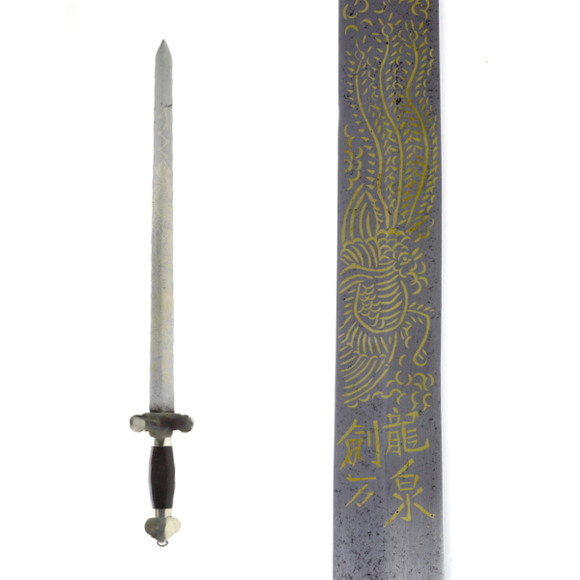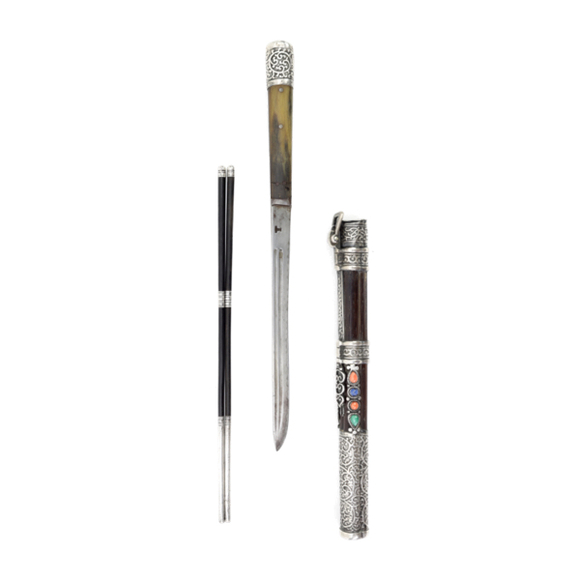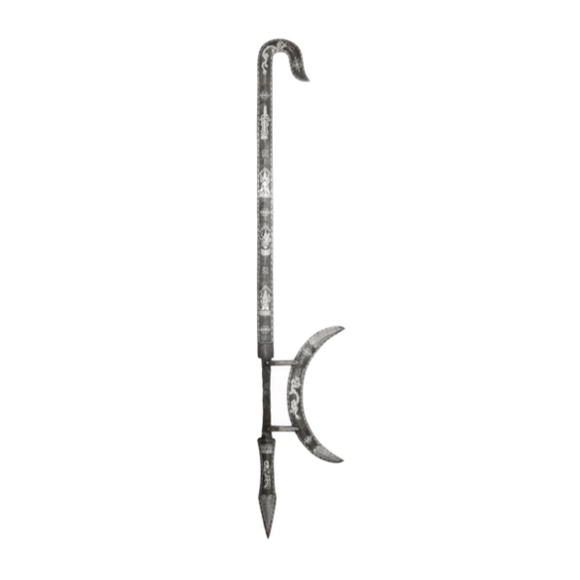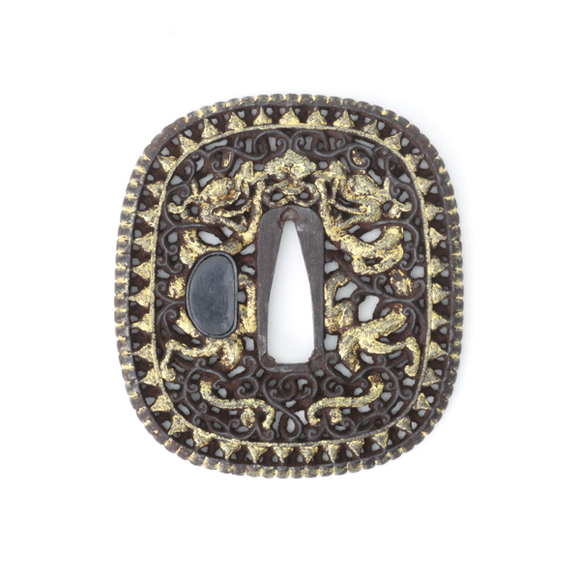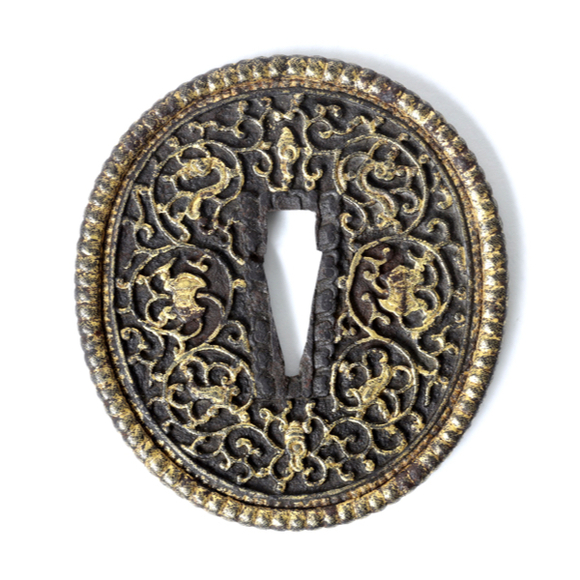A Chinese shortsword made by a well-known Longquan maker.

52.6 cm
39.3 cm
Base 8 mm
Start backedge 5.9 mm
5 cm from tip 3.1 mm
Base 36.6 mm
Start backedge 28.8 mm
5 cm from tip 24.7 mm
344 grams
12.6 cm from base
Iron, steel
China
8th-12th century
Description
An interesting short dāo of archaic form. It is single-edged for most of its length, culminating in a double-edged tip. The blade profile has a noticeable taper in width from base to tip. The spine is ridged, something called iori-mune in Japanese.
The forging shows mainly a straight grain pattern with a high carbon edge plate that is exposed at the leading edge and the sharp backedge. Such work is typical for Chinese manufacture.
The tang appears to consist of two stages. The upper part that connects to the blade seems very old and deeply pitted. The other half, which includes the small hole, appears of a much later date, with a smoother finish. It is not particularly well made and has a tail that may have once been peened over a pommel. The impression is a late, probably 19th-century alteration in order to mount it in specific mounts.
Provenance
The piece was acquired in Japan by a G.I. during World War 2. He sold it to a person named Glen Frank in the 1990s. Apparently, the piece was in a very poor state, and Mr. Frank had it polished by David Hofhine in Japanese sashikomi style (traditional polish), bringing it to its current condition. It was then sent to the N.B.T.H.K. in Japan in 1997, where Tanobe Michihiro examined it.
Tanobe concluded it was most likely ancient, but outside of the expertise of him and his staff. He concluded the shape is that of the warabite-to that come from the 5th-6th century Kofun burial mounds, but none of those have a ridged back (iori-mune) and so it must be somewhat later. He also thought the tang was altered in later times.
The full correspondence in the form of letters are kept with the blade and will be passed on to the next owner.
It was purchased by a private collector in the early 2000s, who consigned it to me.
Dating and attribution
This general blade style is very archaic and was popular in the first centuries A.D., mainly the Sui and Tang dynasties in China, and in Japan the Kofun, and Nara periods, possibly into early Heian. Many of these earlier Japanese swords are thought to have been either made by the Emishi people of Hokkaido, or imported from China or Korea.

Warabite-tō from the Shōsōin.
8th century or earlier.

Warabite-to in its scabbard. Tokyo National Museum.
Heian period (794-1185 A.D.)

Sword with a double-edged tip from the Shōsōin.
8th century or earlier.
It is mainly the ridged spine that sets the piece apart from the earliest warabite-tō. Such spine finishing became pretty much standard during the Heian period, as exemplified by famous old swords such as Yasutsuna's Dojigiri, or Sanjo Munechika's Mikazuki. However, it was not unheard of in the Nara period (710-794 A.D.); There is a small knife called tōso in the Shōsōin in Nara with such a spine, and these holdings predate 759 A.D. when the inventory list was compiled.

The ridged tōso in the Shōsōin, #102.
Published in Honma Junji; Shōsōin no Token by by Shosoin Office, 1974.
Conclusion
I tend to think the piece postdates the Kofun and Asuka periods but may very well date from the Nara to Heian period. If Chinese, that would make it Tang (618-907 A.D.) or Song (960–1279 A.D.) period. Another possibility is that it is of Korean or Emishi make.
Among Chinese sword collectors today, straight-ish sabers with a double-edged tip are often referred to as yànlíngdāo (雁翎刀), "goose feather sword". Presumably, because the tip resembles a feather with the ridge line between the two edges being represented by the feather's quill. Geese were often used as an allegory to soldiers, as they moved in formation behind one leader.
There is a reference from the 13th-century classic Ocean of Jade that mentions the production of goose-feather swords in a time when straight single-edged swords were still common:
清乾道元年命軍器所。造雁翎刀以三千柄為一料
“In the first year of Qiandao (1165), the military workshops made three thousand goose-feather swords in a single order.”
-Ocean of Jade by Wang Ying-lin, Chapter 151
Would these have resembled this sword? Unfortunately, we don't know what the goose-quill sword of the day looked like, but it was most likely straight, as that was the popular form of the day, and double-edged as to resemble the feather.
But Tang is a very real possibility as well; Japan is the only country in the world that has a collection of almost perfectly preserved Tang swords and knives, mostly kept in the imperial repository of the Shōsōin. It could well be that this blade belongs to the group of Nara period gifts and trade items that entered Japan back then and have been very well kept since.
Condition
The piece is in the +/- 25 year old polish by David Hofhine, with some longitudinal scratches, see photos.
Blade is very healthy, no flaws or significant edge damage. It comes in a shirasaya with horn ends.



























Typical Chinese hook sword, with seldom-seen fine silver wire overlay.
With the swirling arabesque motifs that are typical for this period.

